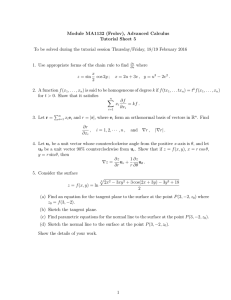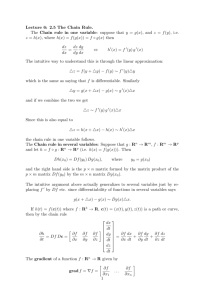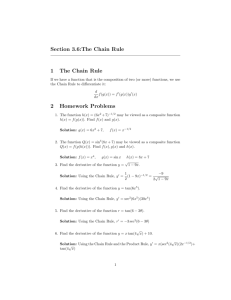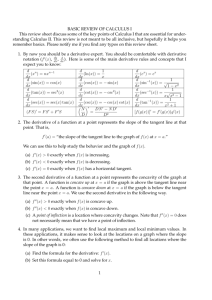MATH 136 CALCULUS 1
advertisement
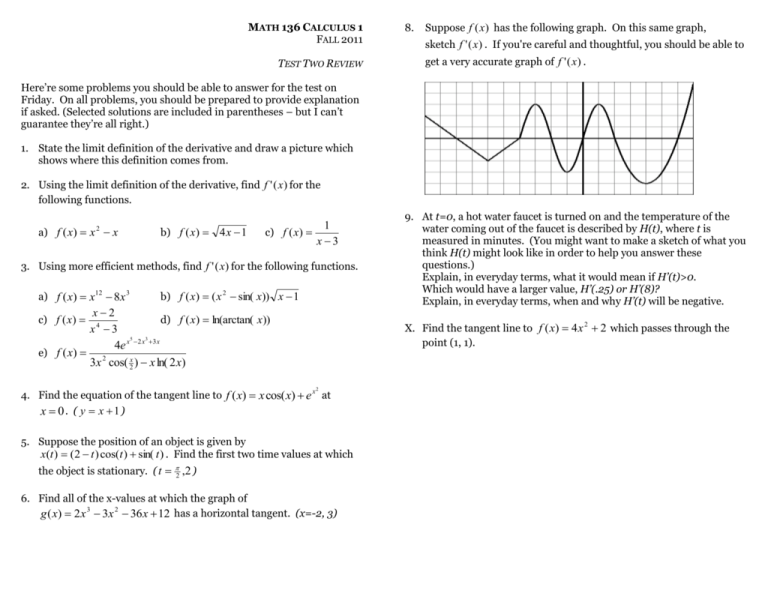
MATH 136 CALCULUS 1 FALL 2011 TEST TWO REVIEW 8. Suppose f (x ) has the following graph. On this same graph, sketch f ' ( x ) . If you're careful and thoughtful, you should be able to get a very accurate graph of f ' ( x ) . Here’re some problems you should be able to answer for the test on Friday. On all problems, you should be prepared to provide explanation if asked. (Selected solutions are included in parentheses – but I can’t guarantee they’re all right.) 1. State the limit definition of the derivative and draw a picture which shows where this definition comes from. 2. Using the limit definition of the derivative, find f ' ( x) for the following functions. a) f ( x) x x 2 b) f ( x) 4x 1 1 c) f ( x) x3 3. Using more efficient methods, find f ' ( x) for the following functions. a) f ( x) x12 8x 3 b) f ( x) ( x 2 sin( x)) x 1 x2 d) f ( x) ln(arctan( x)) x4 3 5 3 4e x 2 x 3 x e) f ( x) 2 3x cos( 2x ) x ln( 2 x) c) f ( x) 9. At t=0, a hot water faucet is turned on and the temperature of the water coming out of the faucet is described by H(t), where t is measured in minutes. (You might want to make a sketch of what you think H(t) might look like in order to help you answer these questions.) Explain, in everyday terms, what it would mean if H’(t)>0. Which would have a larger value, H’(.25) or H’(8)? Explain, in everyday terms, when and why H’(t) will be negative. X. Find the tangent line to f ( x) 4 x 2 2 which passes through the point (1, 1). 4. Find the equation of the tangent line to f ( x) x cos( x) e x at x 0. ( y x 1) 2 5. Suppose the position of an object is given by x(t ) (2 t ) cos(t ) sin( t ) . Find the first two time values at which the object is stationary. ( t 2 ,2 ) 6. Find all of the x-values at which the graph of g ( x) 2 x 3 3x 2 36 x 12 has a horizontal tangent. (x=-2, 3) MATH 136 CALCULUS 1 FALL 2011 TEST TWO REVIEW 8. Suppose f (x ) has the following graph. On this same graph, sketch f ' ( x ) . If you're careful and thoughtful, you should be able to get a very accurate graph of f ' ( x ) . Here’re some problems you should be able to answer for the test on Friday. On all problems, you should be prepared to provide explanation if asked. (Selected solutions are included in parentheses – but I can’t guarantee they’re all right.) 1. State the limit definition of the derivative and draw a picture which shows where this definition comes from. 2. Using the limit definition of the derivative, find f ' ( x) for the following functions. a) f ( x) x x 2 b) f ( x) 4x 1 1 c) f ( x) x3 3. Using more efficient methods, find f ' ( x) for the following functions. a) f ( x) x12 8x 3 b) f ( x) ( x 2 sin( x)) x 1 x2 d) f ( x) ln(arctan( x)) x4 3 5 3 4e x 2 x 3 x e) f ( x) 2 3x cos( 2x ) x ln( 2 x) c) f ( x) 9. At t=0, a hot water faucet is turned on and the temperature of the water coming out of the faucet is described by H(t), where t is measured in minutes. (You might want to make a sketch of what you think H(t) might look like in order to help you answer these questions.) Explain, in everyday terms, what it would mean if H’(t)>0. Which would have a larger value, H’(.25) or H’(8)? Explain, in everyday terms, when and why H’(t) will be negative. X. Find the tangent line to f ( x) 4 x 2 2 which passes through the point (1, 1). 4. Find the equation of the tangent line to f ( x) x cos( x) e x at x 0. ( y x 1) 2 5. Suppose the position of an object is given by x(t ) (2 t ) cos(t ) sin( t ) . Find the first two time values at which the object is stationary. ( t 2 ,2 ) 6. Find all of the x-values at which the graph of g ( x) 2 x 3 3x 2 36 x 12 has a horizontal tangent. (x=-2, 3)
